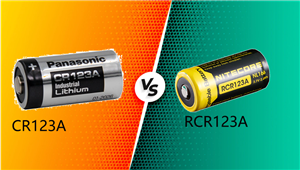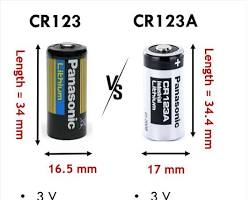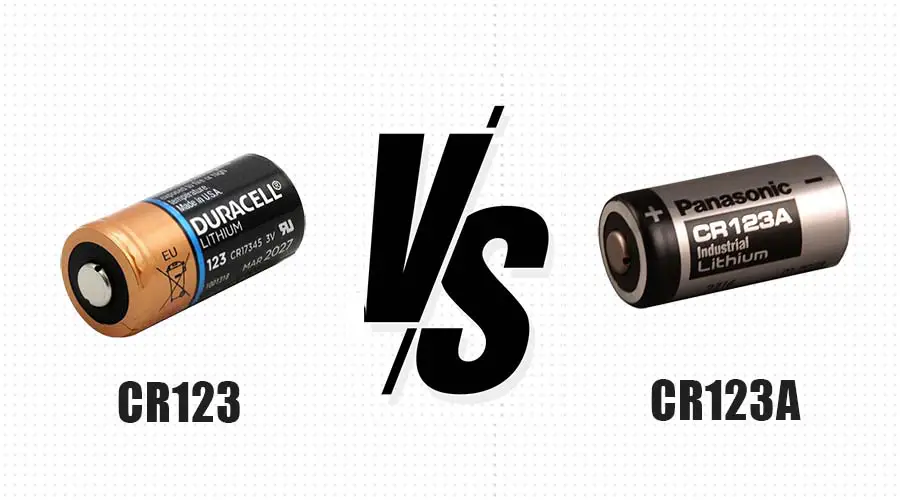Batteries play a pivotal role in supplying power to various electronic devices. Among the numerous types available, CR123 and CR123A stand out as commonly used in many devices. These lithium-based batteries are particularly effective for small, high-output devices such as cameras, light meters, smart home devices, advanced flashlights, tactical equipment, and other battery-powered devices.
This article delves into the difference between CR123 and CR123A batteries. Read on to choose the better one that is fit for your needs.

CR123 vs. CR123A Batteries: How to Choose the Better One?
When choosing between CR123 and CR123A batteries, it's important to consider your specific needs and the requirements of the device you are powering. Here are some factors to consider when deciding which battery type is better suited for your application:
-
Compatibility: In most cases, CR123 and CR123A batteries are used interchangeably since they have similar sizes and specifications. However, it's always a good idea to check the manufacturer's recommendations for your device to ensure compatibility with either type of battery.
-
Battery Performance: Both CR123 and CR123A batteries provide similar performance in terms of voltage output (3 volts) and energy density. They both offer reliable power for high-drain devices, but individual battery brands and variations may have slightly different performance characteristics.
-
Availability: CR123A batteries are more commonly available and may be easier to find in stores compared to CR123 batteries. If convenience and availability are important factors for you, CR123A batteries might be the better choice.
-
Price: Depending on the brand and manufacturer, there may be differences in the pricing of CR123 and CR123A batteries. It's a good idea to compare prices and consider your budget when deciding which type to purchase.
-
Brand Reputation and Quality: Consider the reputation of the battery brand and the quality of the batteries when making your decision. Opting for well-known and reputable brands can ensure that you are getting reliable and high-quality batteries for your devices.
-
Intended Use: Consider the specific requirements of the device you are powering. Certain devices may have specific compatibility or performance requirements that make one type of battery more suitable than the other.
-
Long-Term Use: If you plan on storing batteries for an extended period or using them in devices that require infrequent battery changes, consider the shelf life of the batteries. Both CR123 and CR123A batteries typically have long shelf lives, but it's good to check the expiration dates before purchasing.
In general, both CR123 and CR123A batteries offer reliable power and performance for a variety of devices. When choosing between the two, consider factors such as availability, pricing, compatibility, and your specific device requirements to determine which type of battery is better suited for your needs.

What's the Difference Between CR123 and CR123A Batteries?
CR123 and CR123A batteries are often used interchangeably, and there is a common misconception that they are different. However, in reality, CR123 and CR123A batteries are essentially the same. The "A" in CR123A does not denote a distinct battery type or variation; rather, it is simply used interchangeably with CR123 to indicate the same battery size and specifications.
Here are some key points to remember regarding the CR123 and CR123A batteries:
-
Interchangeability: CR123 and CR123A batteries have the same size, shape, voltage (3 volts), chemistry, and dimensions. They are essentially identical in terms of their electrical and physical characteristics.
-
Compatibility: Devices designed to use CR123 batteries can typically also use CR123A batteries without any issues. Both battery types are commonly used in high-drain devices such as flashlights, cameras, and other electronics.
-
Availability: CR123A batteries are more commonly available and widely produced compared to CR123 batteries. As a result, CR123A batteries are easier to find in stores and online retailers.
-
Marketing Terminology: The use of both "CR123" and "CR123A" labeling by manufacturers can sometimes lead to confusion among consumers. However, it's important to understand that they refer to the same type of battery.
-
Performance: Since CR123 and CR123A batteries are the same, their performance characteristics, such as energy density and voltage output, are identical. The choice between the two often comes down to personal preference and availability.
In summary, there is no significant difference between CR123 and CR123A batteries. Both types are interchangeable and can be used in devices that require batteries of this size and specification. When purchasing these batteries, you can choose either CR123 or CR123A based on availability, pricing, brand preference, or convenience, knowing that they will perform similarly in your devices.
CR123 vs. CR123A Batteries: Comparison Table
| Feature | CR123 | CR123A |
| Dimensions | 17 x 34.5 millimeters | 17 x 34 millimeters |
| Voltage | 3 Volts | 3 Volts |
| Charging voltage | 1.2 Volts | 1.5 Volts |
| Peak output | 3.6 A | 4.2 A |
| Weight | 17 g | 17 g |
| Capacity | 2,000-2,500 mAh | 2,000-2,500 mAh |
| Pulse current | 3,000 mA | 3,000 mA |
| Working life | 2 to5 years | 3- to6 years |
| Performance | better | lower |
| Compatibility | many devices like toys etc | different devices |
| Cost | 5 to10 dollars | 5 to10 dollars |
How do you Know Whether the Batteries Need to be Replaced?

Knowing when to replace batteries in a device is important to ensure optimal performance and prevent any potential issues due to low battery power. Here are some common signs that indicate it may be time to replace the batteries in your device:
-
Diminished Performance: If you notice that the device is not functioning as efficiently as before or is operating at a lower level of performance, it could be a sign that the batteries are running low.
-
Low Power Indicator: Some devices come equipped with a low battery indicator light or icon that notifies you when the battery power is running low. Pay attention to these indicators and replace the batteries as needed.
-
Intermittent Operation: If the device starts to operate intermittently or unexpectedly shuts off, it could be a sign that the batteries are losing their charge and need to be replaced.
-
Reduced Battery Life: If the device is not holding a charge for as long as it used to, it may be time to replace the batteries. This is especially common in rechargeable batteries that have surpassed their optimal charging cycles.
-
Corrosion or Leakage: Check the battery compartment for any signs of corrosion or battery leakage. If you notice any rust, white powder, or liquid residue, it's crucial to replace the batteries immediately and clean the compartment thoroughly.
-
Change in Sound or Performance: Devices that produce sound, such as alarms or sensors, may exhibit changes in sound quality or volume when the batteries are running low. If you notice any differences in the device's performance, consider replacing the batteries.
-
Visual Inspection: In some cases, you may be able to visually inspect the batteries to determine if they need to be replaced. Look for any signs of bulging, leakage, or damage to the battery casing.
-
Use a Battery Tester: A battery tester is a handy tool that can measure the remaining charge in a battery. If you are unsure whether the batteries need to be replaced, using a battery tester can provide you with a clear indication of the battery's remaining power.
By being attentive to these signs and symptoms, you can determine when it's time to replace the batteries in your devices proactively. Regular maintenance and timely battery replacements can help ensure the optimal performance and longevity of your devices.



